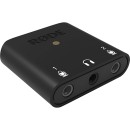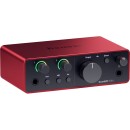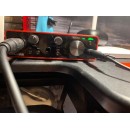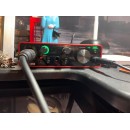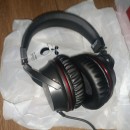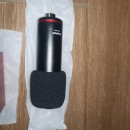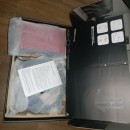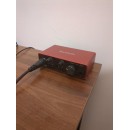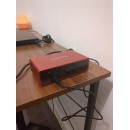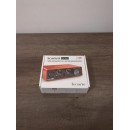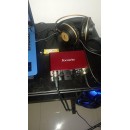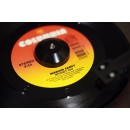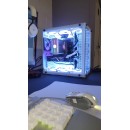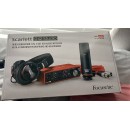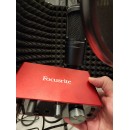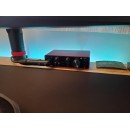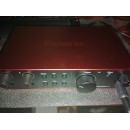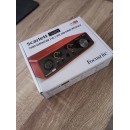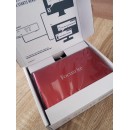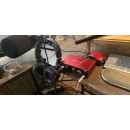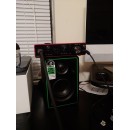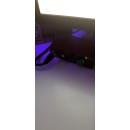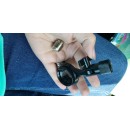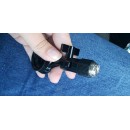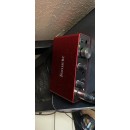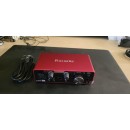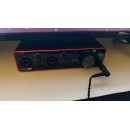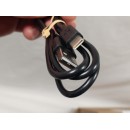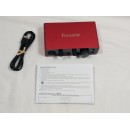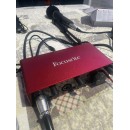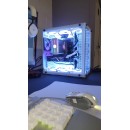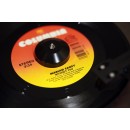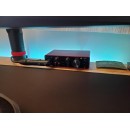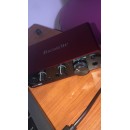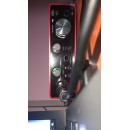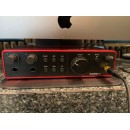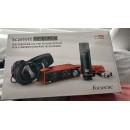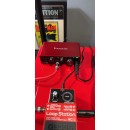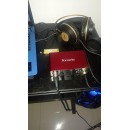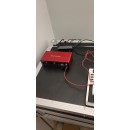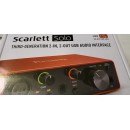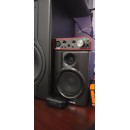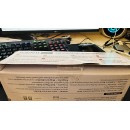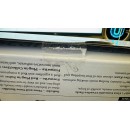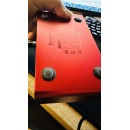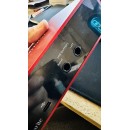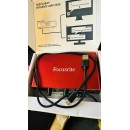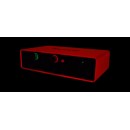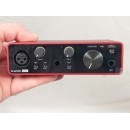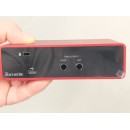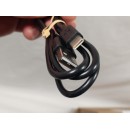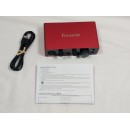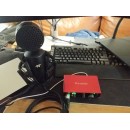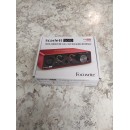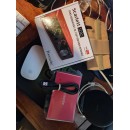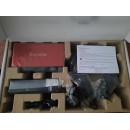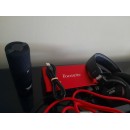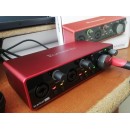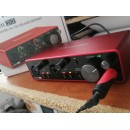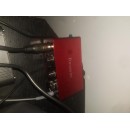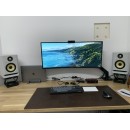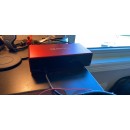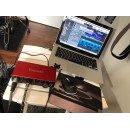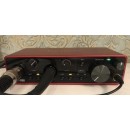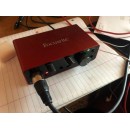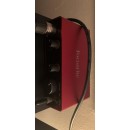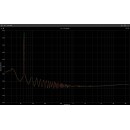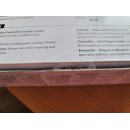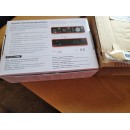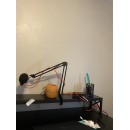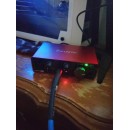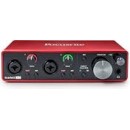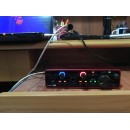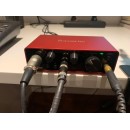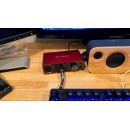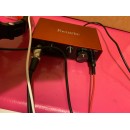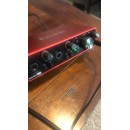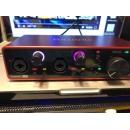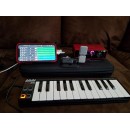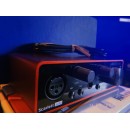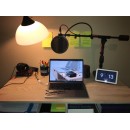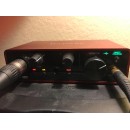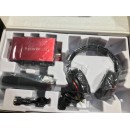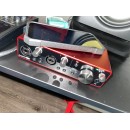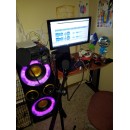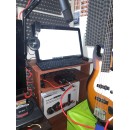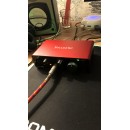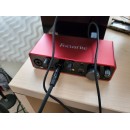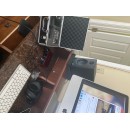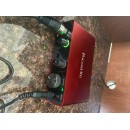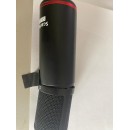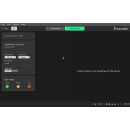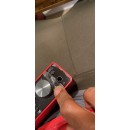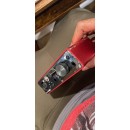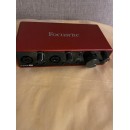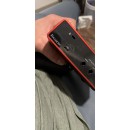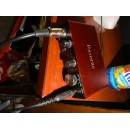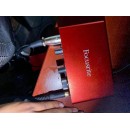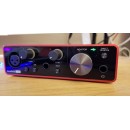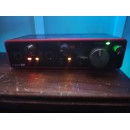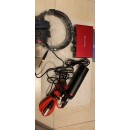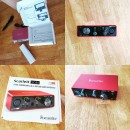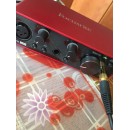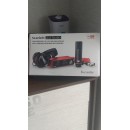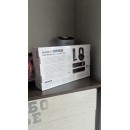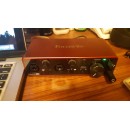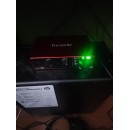RODE AI-Micro USB-C vs Focusrite Scarlett Solo USB-C (4th Generation): A Comprehensive Comparison
The Focusrite Scarlett Solo (4th Gen) is a robust and versatile audio interface known for its superior preamp quality and low-latency performance. It features one Scarlett mic preamp with a switchable Air mode to give recordings a brighter and more open sound. The unit also includes a single high-headroom instrument input for guitars or basses, along with balanced outputs for clean audio playback. The Scarlett Solo is ideal for solo musicians, podcasters, and small home studios, offering up to 24-bit/192kHz A-D/D-A conversion and a direct monitor circuit for zero-latency tracking. Its durable metal chassis and USB-C connectivity ensure both reliability and fast data transfer.
In contrast, the RODE AI-Micro is a compact and highly portable audio interface designed for ease of use and flexibility on the go. It features dual TRS inputs, making it compatible with a wide range of microphones and instruments. The AI-Micro is particularly favored for field recording, mobile podcasting, and video production due to its small footprint and cross-platform compatibility, working seamlessly with iOS, Android, Mac, and Windows devices. The interface also includes a headphone output for real-time monitoring and leverages high-quality preamps for clear and detailed audio capture. Its plug-and-play design minimizes setup time, making it accessible for beginners and professionals alike.
While the Focusrite Scarlett Solo excels in studio settings with its high-quality preamps, balanced outputs, and robust build, the RODE AI-Micro stands out for its portability, dual inputs, and versatility across various devices. Both interfaces offer excellent audio quality, but the choice between them will largely depend on the user's specific recording needs and environment.
Specifications, Advantages, and Disadvantages of RODE AI-Micro and Focusrite Scarlett Solo (4th Gen)
| User Rating Based on Analysis of Reviews | |
|---|---|
|
Show More |
| Pros: | |
|---|---|
|
|
| Cons: | |
|---|---|
|
|
| Key Specs | |
|---|---|
| Channels of I/O | |
| 2 Inputs / 2 Outputs |
Analog: 2 Inputs / 2 Outputs at 192 kHz |
| Maximum Sampling Rate | |
| 48 kHz / 24-Bit | 192 kHz / 24-Bit |
| Number of Microphone Inputs | |
| 2 Preamps | 1 |
| Analog Audio I/O | |
| 2x 1/8" / 3.5 mm TRRS Unbalanced Mic Input 1x 1/8" / 3.5 mm TRS Unbalanced Headphone Output |
1x XLR 3-Pin Balanced Mic Input 1x 1/4" TS Unbalanced Line/Hi-Z Input (Front Panel) 2x 1/4" TRS Balanced Monitor Output 1x 1/4" TRS Headphone Output (Front Panel) |
| Host Connection | |
| 1x USB-C (Class-Compliant) | 1x USB-C |
| OS Compatibility | |
| macOS 11 Windows 10.19,041 14 9.0 |
macOS Windows |
| Power Requirements | |
| USB Bus Power | USB Bus Power, USB Power Adapter (Not Included) |
The Focusrite Scarlett Solo (4th Generation) provides 2 analog inputs and 2 outputs at a maximum sampling rate of 192 kHz / 24-Bit. It includes 1 microphone input via an XLR connector and an additional 1/4" TS unbalanced line/Hi-Z input on the front panel. For outputs, it offers 2x 1/4" TRS balanced monitor outputs and a 1/4" TRS headphone output on the front panel. It connects to a host via USB-C and is compatible with both macOS and Windows operating systems. Power is supplied via USB bus power, and there's an option to use a USB power adapter, though it is not included.
In contrast, the RODE AI-Micro USB-C Audio Interface features 2 inputs and 2 outputs with a maximum sampling rate of 48 kHz / 24-Bit. It has 2 microphone preamps accessible through two 1/8" / 3.5 mm TRRS unbalanced mic inputs. For monitoring, it offers a single 1/8" / 3.5 mm TRS unbalanced headphone output. It also uses USB-C for host connection and is compatible with macOS and Windows operating systems. Similar to the Focusrite, it is powered via USB bus power.
In summary, the Focusrite Scarlett Solo (4th Generation) is geared towards users needing higher sampling rates and more professional connectivity options, such as XLR and balanced TRS outputs, making it suitable for musicians and audio professionals. The RODE AI-Micro, with its dual 1/8" TRRS mic inputs and lower sampling rate, is designed for users seeking a compact and straightforward solution for mobile recording or podcasting.
| General | |
|---|---|
| Channels of I/O | |
| 2 Inputs / 2 Outputs |
Analog: 2 Inputs / 2 Outputs at 192 kHz |
| Maximum Sampling Rate | |
| 48 kHz / 24-Bit | 192 kHz / 24-Bit |
| Number of Microphone Inputs | |
| 2 Preamps | 1 |
| Input Level Adjustment | |
| 2x via Software | 2x Knob |
| Expansion Slots | |
The Focusrite Scarlett Solo USB-C Audio Interface (4th Generation) supports analog channels with 2 inputs and 2 outputs at a maximum sampling rate of 192 kHz with 24-bit depth. It includes one microphone input and offers input level adjustment through two physical knobs. However, it lacks built-in DSP and expansion slots, and it does not feature a built-in microphone.
In contrast, the RODE AI-Micro USB-C Audio Interface provides 2 inputs and 2 outputs, with a maximum sampling rate of 48 kHz at 24-bit depth. It stands out by featuring two microphone preamps, offering greater flexibility for users needing to connect multiple microphones. Input level adjustment is managed via software rather than physical knobs. Similar to the Focusrite Scarlett Solo, it does not include built-in DSP, expansion slots, or a built-in microphone.
In summary, the Focusrite Scarlett Solo excels with its higher sampling rate and physical input level adjustment knobs, making it ideal for users seeking high-resolution audio recording and tactile control. On the other hand, the RODE AI-Micro offers dual microphone preamps and software-based input level adjustment, catering to those who need to connect multiple microphones and prefer software control.
| Signal Processing | |
|---|---|
| Gain/Trim Range | |
| -24 to 0 dB |
Mic/Line Inputs: Up to +69 dB Hi-Z Inputs: 62 dB |
The Focusrite Scarlett Solo offers a robust Gain/Trim Range, with Mic/Line Inputs allowing up to +69 dB and Hi-Z Inputs providing up to 62 dB. This wide gain range makes it especially versatile for handling various input sources, from microphones to high-impedance instruments like electric guitars. The high gain levels ensure that even low-sensitivity microphones can deliver strong, clear signals without requiring external pre-amplification.
On the other hand, the RODE AI-Micro USB-C Audio Interface features a more modest Gain/Trim Range, adjustable from -24 to 0 dB. While this range is narrower compared to the Scarlett Solo, it is tailored for specific recording scenarios. The RODE AI-Micro also provides a High-Pass Filter adjustable between 75 to 150 Hz via software, which can effectively reduce low-frequency rumble and improve overall recording clarity. However, it lacks additional features such as a pad and solo/mute functions.
In summary, the Focusrite Scarlett Solo 4th Generation is designed to offer extensive gain flexibility and accommodate a wide variety of audio sources, making it a versatile choice for both home studios and professional settings. The RODE AI-Micro, with its more limited gain range and built-in high-pass filter, is suitable for users who need a compact, straightforward interface with basic but effective features.
| Connectivity | |
|---|---|
| Analog Audio I/O | |
| 2x 1/8" / 3.5 mm TRRS Unbalanced Mic Input 1x 1/8" / 3.5 mm TRS Unbalanced Headphone Output |
1x XLR 3-Pin Balanced Mic Input 1x 1/4" TS Unbalanced Line/Hi-Z Input (Front Panel) 2x 1/4" TRS Balanced Monitor Output 1x 1/4" TRS Headphone Output (Front Panel) |
| Phantom Power | |
| 48 V, Selectable On/Off | |
| Digital Audio I/O | |
| Host Connection | |
| 1x USB-C (Class-Compliant) | 1x USB-C |
| Host Connection Protocol | |
| Not Specified by Manufacturer | USB 2.0 |
| USB (Non-Host) | |
| Sync I/O | |
| Network I/O | |
| MIDI I/O | |
The Focusrite Scarlett Solo USB-C Audio Interface (4th Generation) is equipped with a comprehensive array of analog audio inputs and outputs. It boasts 1x XLR 3-pin balanced mic input, 1x 1/4" TS unbalanced line/Hi-Z input on the front panel, and 2x 1/4" TRS balanced monitor outputs. Additionally, it includes a 1/4" TRS headphone output on the front panel. The Scarlett Solo provides 48V selectable phantom power, making it versatile for different microphone types, including condenser mics. However, it lacks digital audio I/O, MIDI I/O, network I/O, and wireless capabilities. The interface connects to the host via 1x USB-C using the USB 2.0 protocol.
In contrast, the RODE AI-Micro USB-C Audio Interface is more streamlined in its design, featuring 2x 1/8" (3.5 mm) TRRS unbalanced mic inputs and 1x 1/8" (3.5 mm) TRS unbalanced headphone output. It does not support phantom power, which limits its use with certain types of microphones that require external power. Like the Scarlett Solo, the AI-Micro lacks digital audio I/O, MIDI I/O, network I/O, and wireless capabilities. The AI-Micro connects to the host via 1x USB-C and is class-compliant, although the specific host connection protocol is not specified by the manufacturer.
In summary, the Focusrite Scarlett Solo offers a more robust set of I/O options and phantom power support, making it suitable for more complex recording needs. On the other hand, the RODE AI-Micro is a simpler, more portable solution, ideal for users requiring basic audio input and output functionality without the need for additional power or connectivity options.
| Performance | |
|---|---|
| Frequency Response | |
| 20 Hz to 20 kHz |
XLR Mic Inputs: 20 Hz to 20 kHz ±0.06 dB 1/4" Line Inputs: 20 Hz to 20 kHz 0.05 dB 1/4" Hi-Z Inputs: 20 Hz to 20 kHz 0.15 dB |
| Headphone Output Power | |
| 125 mW into 32 Ohms |
1/4": 32 mW into 33 Ohms 22 mW into 300 Ohms |
| Dynamic Range | |
| 100 dB (A-Weighted) |
XLR Mic Inputs: 113 dBA 1/4" Line Inputs: 113 dBA 1/4" Hi-Z Inputs: 112 dBA 1/4" Line Outputs: 120 dB 1/4" Headphone: 112 dB (at 33 Ohms) 115 dB (at 300 Ohms) Digital A/D Converters: 120 dB Digital D/A Converters: 130 dBA |
Starting with the frequency response, the Focusrite Scarlett Solo offers detailed specifications across its various inputs: XLR Mic Inputs (20 Hz to 20 kHz ±0.06 dB), 1/4" Line Inputs (20 Hz to 20 kHz 0.05 dB), and 1/4" Hi-Z Inputs (20 Hz to 20 kHz 0.15 dB). In contrast, the RODE AI-Micro offers a general frequency response of 20 Hz to 20 kHz, without specifying deviations or variations across different inputs.
In terms of maximum input levels, the Focusrite Scarlett Solo provides specific values: XLR Mic (9.5 dBu), 1/4" Line (22 dBu), and 1/4" Hi-Z (12 dBu). The RODE AI-Micro does not specify maximum input levels, which could be a consideration for users with varying input requirements.
When comparing maximum output levels, the Focusrite Scarlett Solo lists its 1/4" Line output at +16 dBu. On the other hand, the RODE AI-Micro does not provide a specific maximum output level for line outputs but does offer a significantly higher headphone output power of 125 mW into 32 Ohms, compared to the Focusrite's 1/4" headphone output power of 32 mW into 33 Ohms and 22 mW into 300 Ohms.
Impedance specifications for the Focusrite Scarlett Solo are thorough: XLR Mic Inputs (3 Kilohms), 1/4" Line Inputs (60 Kilohms), 1/4" Hi-Z Inputs (1 Megohm), 1/4" Line Outputs (200 Ohms), and 1/4" Headphone Outputs (< 50 Ohms). The RODE AI-Micro does not provide detailed impedance values, which might be a limitation for users requiring precise impedance matching.
The dynamic range is another area where the Focusrite Scarlett Solo excels with detailed figures: XLR Mic Inputs (113 dBA), 1/4" Line Inputs (113 dBA), 1/4" Hi-Z Inputs (112 dBA), 1/4" Line Outputs (120 dB), and 1/4" Headphone (112 dB at 33 Ohms, 115 dB at 300 Ohms). Its digital A/D and D/A converters offer dynamic ranges of 120 dB and 130 dBA, respectively. The RODE AI-Micro, while providing a decent dynamic range of 100 dB (A-Weighted), falls short of the extensive dynamic range offered by the Focusrite Scarlett Solo.
Finally, the Total Harmonic Distortion plus Noise (THD+N) and Equivalent Input Noise (EIN) are critical for ensuring clean audio. The Focusrite Scarlett Solo lists very low THD+N values across different inputs and outputs: XLR Mic Inputs (-100 dB at Minimum Gain), 1/4" Line Inputs (-100 dB at 8 dB Gain), 1/4" Hi-Z Inputs (-80 dB at Minimum Gain), 1/4" Line Outputs (-100 dB at Minimum Gain), and 1/4" Headphone Outputs (-97 dB at 33 Ohms, -102 dB at 300 Ohms). Its digital converters also exhibit low THD+N (A/D: -110 dB, D/A: -115 dB). Additionally, the EIN for the XLR Mic Inputs is an impressive -127 dBu A-Weighted. The RODE AI-Micro does not provide these specific THD+N and EIN values, which might be a drawback for users needing detailed noise performance metrics.
In conclusion, while both audio interfaces offer robust performance, the Focusrite Scarlett Solo USB-C Audio Interface (4th Generation) provides more detailed specifications and higher performance metrics across various features, making it a more versatile choice for professional audio applications. The RODE AI-Micro USB-C Audio Interface, with its higher headphone output power, might appeal to users with a focus on headphone monitoring but lacks the detailed specifications provided by the Focusrite Scarlett Solo.
| Digital Audio | |
|---|---|
| Sample Rates | |
| 44.1 / 48 kHz | 44.1 / 48 / 88.2 / 96 / 176.4 / 192 kHz |
| Bit Depths | |
| 24-Bit | 24-Bit |
| Sync Sources | |
| Internal | Internal |
The Focusrite Scarlett Solo (4th Generation) offers a wide range of sample rates, including 44.1, 48, 88.2, 96, 176.4, and 192 kHz, thus providing greater flexibility for users who require high-fidelity audio recording and playback. It supports a 24-bit depth, ensuring high-resolution audio quality. The interface uses internal sync sources, which is standard for maintaining audio consistency and reliability.
On the other hand, the RODE AI-Micro USB-C Audio Interface supports more limited sample rates of 44.1 and 48 kHz, which are sufficient for most general recording purposes but may not meet the demands of high-resolution audio production. Like the Scarlett Solo, it supports 24-bit depth, ensuring good audio resolution. One notable feature of the RODE AI-Micro is its zero-latency direct monitoring, which allows users to hear their input in real-time without any noticeable delay, a crucial aspect for live performance and accurate monitoring. The RODE AI-Micro also relies on internal sync sources for stable audio performance.
In summary, the Focusrite Scarlett Solo (4th Generation) excels in offering higher and more varied sample rates, appealing to users who prioritize audio fidelity and versatility. Conversely, the RODE AI-Micro stands out with its zero-latency direct monitoring feature, making it a suitable choice for users needing real-time audio feedback during recording or live sessions. Both interfaces share a 24-bit depth and internal sync sources, ensuring reliable and high-quality audio output.
| Audio Storage & Playback |
|---|
| Compatibility | |
|---|---|
| OS Compatibility | |
| macOS 11 Windows 10.19,041 14 9.0 |
macOS Windows |
The Focusrite Scarlett Solo USB-C Audio Interface (4th Generation) is compatible with macOS and Windows operating systems, making it versatile for desktop and laptop users. Additionally, it has limited mobile app compatibility, specifically with iPadOS, which allows some level of mobile recording flexibility.
In contrast, the RODE AI-Micro USB-C Audio Interface has broader mobile device compatibility. It works with macOS 11 and Windows 10.19,041, and is also compatible with a range of mobile devices, including iPad, iPhone, Android smartphones, and Android tablets. This makes the RODE AI-Micro a more versatile option for users who need to interface with various devices, whether they use Lightning, USB-A, or USB-C ports. Moreover, an internet connection is required for registration and software/driver downloads.
When it comes to included software and plug-ins, the Focusrite Scarlett Solo does not specify any included software in the provided specifications, whereas the RODE AI-Micro explicitly states that it does not include any software or plug-ins. This could be a consideration for users who might be looking for a more all-in-one solution or those who already have their preferred software and plug-ins.
Overall, the Focusrite Scarlett Solo USB-C Audio Interface (4th Generation) appears more tailored for traditional desktop and limited iPadOS use, while the RODE AI-Micro USB-C Audio Interface offers broader compatibility across multiple operating systems and mobile devices, making it a more flexible option for users who need to connect to various hardware configurations.
| Power | |
|---|---|
| Power Requirements | |
| USB Bus Power | USB Bus Power, USB Power Adapter (Not Included) |
In terms of power consumption, the Focusrite Scarlett Solo requires 4.5 watts, indicating a relatively low power draw that should be manageable for most modern USB ports. The RODE AI-Micro, while not specifying exact power consumption, operates solely on USB bus power, implying a design optimized for minimal power usage. This makes the RODE AI-Micro potentially more efficient and easier to integrate into a broader range of USB-powered setups without straining the power capabilities of the host device.
Overall, both interfaces are designed for simplicity and ease of use, but the Focusrite Scarlett Solo provides additional power options that might be beneficial for users requiring more stable or higher power input. The RODE AI-Micro, on the other hand, stands out for its streamlined, bus-powered operation tailored for straightforward, plug-and-play use.
| Physical | |
|---|---|
| Dimensions | |
| 1.6 x 1.5 x 0.4" / 40 x 38.2 x 11.1 mm | 5.63 x 3.78 x 1.79" / 14.3 x 9.6 x 4.55 cm |
| Weight | |
| 0.5 oz / 13.0 g | 0.8 lb / 363.0 g |
In terms of dimensions, the Focusrite Scarlett Solo (4th Generation) measures 5.63 x 3.78 x 1.79 inches (14.3 x 9.6 x 4.55 cm), making it a more substantial and larger device compared to the RODE AI-Micro, which is significantly more compact at 1.6 x 1.5 x 0.4 inches (40 x 38.2 x 11.1 mm). This difference in size indicates that the Scarlett Solo is better suited for stationary setups, while the AI-Micro is designed for portability and on-the-go use.
When it comes to weight, the Scarlett Solo weighs 0.8 lbs (363.0 g), which is relatively light but still considerably heavier than the RODE AI-Micro, which weighs a mere 0.5 oz (13.0 g). The light weight of the AI-Micro makes it an ideal choice for users who need a highly portable audio interface that can be easily carried in a pocket or a small bag.
Overall, the Focusrite Scarlett Solo USB-C Audio Interface (4th Generation) offers a larger and slightly heavier design, making it more suitable for users who prioritize a robust, stationary setup. In contrast, the RODE AI-Micro USB-C Audio Interface is ultra-compact and lightweight, catering to users who need a highly portable solution for their audio recording needs.
| Packaging Info | |
|---|---|
| Package Weight | |
| 0.2 lb | 1.305 lb |
| Box Dimensions (LxWxH) | |
| 5.5 x 3.3 x 1.6" | 7.2 x 6.1 x 2.5" |
In terms of packaging dimensions, the Focusrite Scarlett Solo measures 7.2 x 6.1 x 2.5 inches. This provides a bulkier and more substantial form factor compared to the RODE AI-Micro, which has more compact packaging dimensions of 5.5 x 3.3 x 1.6 inches. The larger dimensions of the Scarlett Solo suggest it may take up more space in a studio setup but could also indicate a more robust build or additional input/output options.
Overall, the Focusrite Scarlett Solo is more substantial both in weight and size, which may appeal to users looking for a more durable and potentially feature-rich audio interface. On the other hand, the RODE AI-Micro, with its lighter weight and smaller dimensions, offers a more portable solution, ideal for on-the-go recording needs.
| Customer Images | |
|---|---|
| Videos | |
|---|---|
|
|
|
